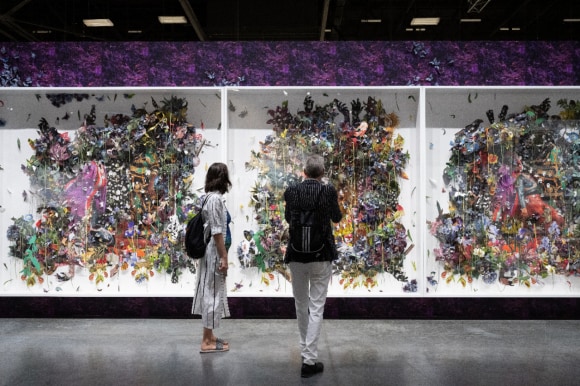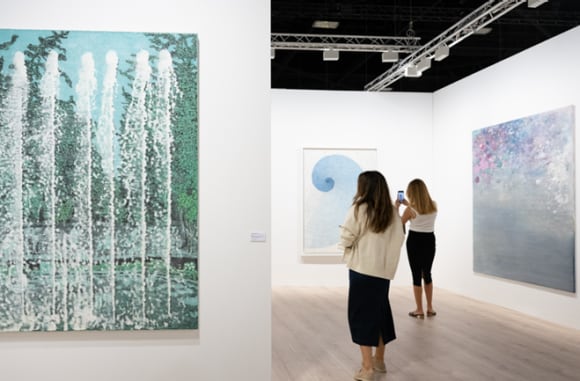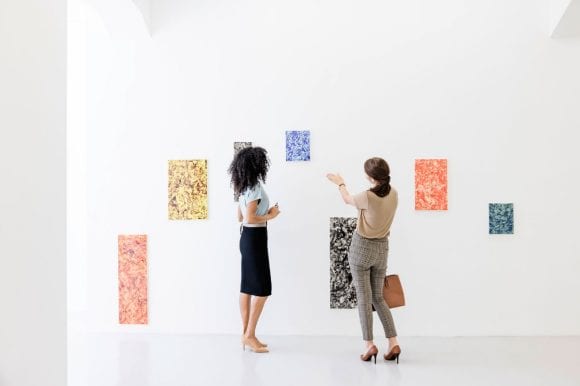

The global art market has once again shown its resilience in the face of high interest rates, inflation, and political instability. While the top end of the market slowed in 2023, transaction volumes increased, and online sales continued to thrive.
The Art Market 2024, published by Art Basel and UBS provides a comprehensive macro-economic analysis of the state of the global art market in 2023. The report sheds light on complex global developments that affect the art market and analyses the key trends that have shaped the market over the last year. Co-published by Art Basel and UBS, the report is authored by renowned cultural economist Dr. Clare McAndrew of Arts Economics. Here we share five key findings from the report, which can be downloaded by clicking the download button.
Global art sales slowdown, whilst transaction volume increases
In 2023, global art sales eased to an estimated USD 65 billion, showcasing resilience despite a slowdown of 4% year-on-year and surpassing pre-pandemic 2019 levels. Notably, transaction volume increased by 4%, totalling 39.4 million, which was particularly pronounced at lower price levels.
US maintains its position as largest global art market
The US maintained its position as the leading market worldwide, accounting for 42% of sales by value. China became the second-largest global art market, with its share rising to 19%, while the UK moved to third place with a share of 17%. France remained in a stable fourth position at 7% of global sales.
Sales in China grow following easing of pandemic measures
Defying the global trend, sales in China increased by 9% to an estimated USD12.2 billion. Following the lifting of COVID-19 restrictions in the first half of the year, buyers capitalized on sales of postponed auction inventories from 2022 and returned to fairs and exhibitions with enthusiasm. In the latter half of 2023, the pace moderated, possibly influenced by projections of more gradual economic growth.
Online sales grow in importance
Confidence in global online sales resurged in 2023, reaching an estimated USD11.8 billion, a rise of 7% year-on-year from 2022, and accounting for 18% of the market’s total turnover.
Outlook for 2024
Expected declines in interest rates, weakening inflation and the enduring allure of art, signals a hopeful outlook for 2024 and beyond.

Discover the insights from a panel of experts discussing key findings from the report and the varying factors that shaped the art market in the last year.
6 insights from The Art Basel and UBS Survey of Global Collecting in 2023
How have collector habits evolved in the first half of 2023? What purchasing methods do they prefer? Are there any new trends on the horizon?
The Art Basel and UBS Survey of Global Collecting in 2023 reveals insights into high-net-worth collector attitudes, behaviors and outlook for the art market. Written by cultural economist Dr. Clare McAndrew, and based on a survey of over 2,800 collectors across 11 art markets, the report looks at collectors’ spending, motivations of their activities in the market, and how they interact with artists, galleries, institutions, and their environment. This survey continues the valuable research conducted over the past eight years by Art Economics and UBS.
Here are six key findings from the report:
Imports of art and antiques across borders reached their highest-ever level of $30.7 billion in 2022, and exports their second highest at $33.4 billion. While global imports across all industries were down in the first quarter of 2023, the value of inflows of art to key hubs continued to grow, including double-digit increases in Hong Kong (50%), the UK (38%), and the US (15%).
The median expenditure on fine art and antiques by collectors surveyed across 11 markets worldwide reached $65,000 in the first half of 2023, up by 19% on 2021. Collectors from Mainland China reported the highest median expenditure in the first half of 2023, at $241,000, showing a strong return to spending post-lockdown.
44% of collectors surveyed identified themselves as a ‘researcher’, engaging in significant amounts of research before acquiring works (up from 37% in 2021). There was a slight drop in impulse buyers (down by 3%).
The median level of spending by women at $72,500 outpaced that of men in 2023, continuing to grow in value and reaching a higher level than in 2022. However, there were more male collectors than women among the narrow segment of those spending over $1 million in each period.
The resurgence of in-person buying continued in 2023. 86% of HNW collectors purchased from a dealer, and of those, 84% bought in person from their gallery or premises (up from 73% in 2022).
Despite ongoing uncertainties, 77% of HNW collectors surveyed remained optimistic about the art market’s performance over the next six months.
5 Insights from the Art Basel and UBS Global Art Market Report
The global art market has demonstrated continued resilience in the face of economic and geopolitical challenges. What factors drove this development? Which markets performed well? What new opportunities does it offer in 2023?
The Art Basel and UBS Global Art Market Report 2023 provides a comprehensive macro-economic analysis of the state of the global art market in 2022.
The report examines the lingering effects of the pandemic and forecasts trends that could be seen entering this year. Co-published by Art Basel and UBS, the report is authored by renowned cultural economist Dr. Clare McAndrew of Arts Economics.
Here we share five key findings from the report, which can be downloaded by clicking the download button.
Global art sales increased 3% year-on-year to an estimated USD 67.8 billion, the second year of growth after a strong recovery in sales of 31% in 2021, and bringing the market higher than its pre-pandemic level in 2019. The key driver of growth continued to be the high end of the market.
The US retained its premier position in the global ranks, with its share of sales by value increasing by 2% year-on-year to 45%. The UK market moved back into second place with 18% of sales, and China’s share decreased 3% to 17%, falling back into third position.
The US art market has seen one of the most robust recoveries of all the major markets. Sales bounced back strongly from the pandemic in 2021 and growth continued in 2022 bringing the market to USD 30.2 billion, its highest level to date.
As live events ran on much fuller schedules and collectors began to reengage, both dealers and auction houses reported a further reduction in the share of their sales accounted for by e-commerce in 2022. Online-only sales fell to USD 11.0 billion, a decline of 17% from the 2021 peak of USD 13.3 billion, but still 85% higher than in 2019.
Having a very low share of representation of female artists was correlated with lower year-on-year sales growth performance for galleries, while those with a share of over 80% had higher than average growth of 21%. While there may be many factors that drive performance, the findings indicate again that having a higher share of women has not been a negative factor for sales in 2022, but having very few could be.
6 insights from A Survey of Global Collecting in 2022 by Art Basel and UBS
Key takeaways from HNW collectors into their spending, trade within the art market and outlook
This year saw the return of art fairs and live events. What has become their preferred purchasing channel? How has their behaviour changed in the first half of 2022?
Written by Dr. Clare McAndrew, founder of Arts Economics, and based on a survey of more than 2,700 collectors in 11 key global markets, conducted in collaboration with UBS, the new report examines the willingness of collectors to travel and attend events post-COVID, as well as their changing sentiment towards buying locally versus internationally. The report also profiles the composition of their collections in terms of gender, artist status, and other key variables; and examines the international trade in art across borders.
A Survey of Global Collecting in 2022 continues the research conducted over the past seven years by Art Economics and UBS and is the largest of the surveys conducted to date.
Here we share six key findings from the report, which can be downloaded by clicking the download button.

Global imports of art and antiques increased 41% in 2021, with exports up 38%, and double-digit increases continuing into the first half of 2022 compared the same period in 2021. If cross-border trade continues at this pace for the rest of this year, record levels could be reached by the end of 2022, indicative of confidence in the major art markets.
Median expenditure by HNW collectors increased in all markets during the first half of 2022, especially in France, Mainland China and Hong Kong. At USD 180,000 over the first six months of the year, it was higher than the entire year in 2021 (USD 164,000), with both surpassing averages in pre-pandemic 2019 (at USD 100,000). Despite the uncertain times we live in, most of the HNW collectors surveyed (78%) were optimistic about the global art market’s performance over the second half of this year.
Almost three-quarters (74%) of collectors surveyed had purchased work at an art fair in 2022, compared with just more than half (54%) in 2021. As more and more real-world fairs returned, 65% said that they had bought a work at an in-person event (up from 37% in 2021), while 59% were still buying through art-fair online viewing rooms.
Live art fairs may have returned, but 95% of the HNW collectors surveyed said they had purchased works of art without viewing them in person, and just over half (51%) said they did this regularly.
HNW collectors consider their carbon footprint one of their four chief concerns when thinking about buying a work of art, and 57% say they are willing to pay up to 25% on top of the purchase price in order to reduce the environmental impact of their acquisition, from its creation to shipping and packaging. Almost all (98%, up from 90% in 2019) said that they would opt for a sustainable option even if it was more expensive and slower.
The pandemic also appears to have encouraged philanthropic giving among some collectors, with 45% intending to donate works to a museum over the next 12 months, up from 29% in 2020 and 43% in 2021.
5 Insights from the Art Basel and UBS Global Art Market Report 2022
Key findings from our annual analysis of the global art market
The art market proved its resilience in 2021, but did it fully regain the ground lost during the pandemic? Did the shift online continue unabated, and what was the impact of the rise of NFTs? Authored by renowned cultural economist Dr Clare McAndrew, Arts Economics, the Art Basel and UBS Global Art Market Report offers the definitive guide to the rapidly changing art market landscape.
The report also features results from a survey of over 2,000 HNW art collectors across 10 key markets by UBS Investor Watch and Arts Economics – providing insights into buyer behavior.
Here, we share five findings from the 2022 report, which can be downloaded by clicking the download button.
The art market bounced back strongly in 2021, with aggregate sales of art and antiques by dealers and auction houses reaching an estimated USD 65.1 billion. Representing a 29% increase on the previous year, this figure outstrips the market’s 2019 value by USD 0.7 billion. The US remained dominant with a share of 43% of global sales by value, while the UK slipped back behind Greater China to third place. Meanwhile the French art market saw its strongest year in a decade produce an impressive 50% uplift in sales year-on-year.
The UBS Investor Watch and Arts Economics survey indicated an increased dedication from HNW collectors, who on average purchased more art and antiques in 2021 than they did in 2020. The value of their purchases also rose, with median spend more than doubling and the proportion spending over USD 1 million also rising dramatically.
Dealers remained the preferred channel for buying art amongst the HNW collectors surveyed, with 76% having purchased through this channel at some point in the year. While online sales retained a greatly increased share of total art sales by value compared to 2019, if given a choice between offline and online experiences, most HNW collectors (69%) still preferred to view art for sale in person at a gallery or fair. 19% preferred to view art online, and 12% were indifferent.
Outside the art market, the total sales value of art-related NFTs on the Ethereum, Flow and Ronin blockchains increased over a hundredfold to USD 2.6 billion. NFTs appear to hold growing appeal to HNW art collectors, with 74% of those surveyed having purchased art-related NFTs in 2021. Following landmark sales at auction, interest shows no sign of abating, with only 4% of HNW collectors surveyed stating they were not at all interested in purchasing NFTs in future. Discover more analysis
The pandemic reconfigured societies and forced us to rethink how we collect and engage with art. For some HNW collectors this has led to a growing emphasis on philanthropic giving, with a substantial increase in those intending to donate works to a museum within the next 12 months – up from 29% in 2020 to 43% across the 10 markets surveyed. This share was highest in France (56%) and the US (50%).
5 insights from the Art Basel and UBS mid-year review 2021
Our new report provides fresh insights into the art market with data from more than 700 dealers and 500 high-net-worth collectors
How has an unprecedented period shaped the art market? The Art Basel and UBS mid-year review ‘Resilience in the Dealer Sector’ provides fresh insight, analyzing the global dealer sector in the first half of 2021 amid the continued challenges of the COVID-19 pandemic. Authored by renowned cultural economist Dr. Clare McAndrew, the report is based on responses from more than 700 dealers operating across 54 regions or countries.
It also integrates fresh insights from a survey of 500 high-net-worth collectors, conducted by Arts Economics and UBS Investor Watch across five markets (the US, the UK, Hong Kong SAR (China), Germany, and Switzerland), as well as data from UBS Evidence Lab. Here, we share five key findings:

51% of dealers surveyed reported an increase in sales in the first half of 2021, versus the same period in 2020. Dealers in Asia reported the biggest improvement in sales, with an average increase of 18% - including a rise of 6% for businesses in Greater China. The most challenging environment was in Europe, where dealers reported an average decline of 7%.
Collectors surveyed remained active in the first half of 2021 – with the median expenditure on art and antiques jumping by 42% on average, to USD 242,000, compared to USD 170,000 across the whole of 2020. Millennial collectors had the highest expenditure overall, at USD 378,000 – more than three times the level of Gen X and Boomers.
In the first half of 2021, spending by female collectors increased by just over one third to $410,000 – more than double the level of their male peers, which saw growth from 2020 of just 9% to $163,000. There was also evidence that female artists are becoming better represented in collections, accounting for 42% of all works, versus 39% in 2020, and 37% in 2019.
Online channels accounted for 33% of all dealers’ sales (or 37%, including art fair Online Viewing Rooms) – more than double their share in 2019. The greatest number of online sales were made via dealers’ own online channels – including their websites and OVRs, social media channels, and email.
Our survey revealed that 77% of collectors surveyed are thinking about sustainable options when it comes to purchasing works of art or the management of their collections. Christl Novakovic, CEO UBS Europe SE and Head Wealth Management Europe and Chair of The UBS Art Board, said: “Out of crisis springs innovation and drive for change, and UBS aims to collaborate further with collectors to make advances in these areas.”
5 Insights from the Art Basel and UBS Global Art Market Report 2021
Discover key findings from our annual analysis of the global art market – from the impact of COVID-19, to digital innovation and growth in female spending.
How did the art market perform in an unprecedented year? Authored by renowned cultural economist Dr Clare McAndrew, the Art Basel and UBS Global Art Market Report offers the definitive guide, analyzing the impact of COVID-19 and other forces that continue to shape the market in 2021 and beyond.
The report features results from a survey of more than 2,500 collectors across 10 key markets by UBS Investor Watch and Arts Economics – providing fresh insights into buyer behavior. Here, we share five findings from the report, which can be downloaded by clicking the download button.

The figure was down 22% on 2019, but still above the 2009 recession low, when sales fell by 36% to USD 39.5 billion. The US market retained its position as leader, with a share of 42% of global sale values. Greater China and the UK followed, on par at 20% - however Greater China overtook the US to become the largest public auction market, with a share of 36% of sales by value.
Though the pandemic forced many auction houses, galleries and fairs to abandon in-person activity, it also accelerated digital transformation. Online sales doubled in value from 2019 to reach a record high of USD 12.4 billion. The figure represented a record 25% share of the market’s total value - the first time the share of e-commerce in the art market has exceeded that of general retail..
Despite having fewer opportunities to buy in-person, collectors surveyed remained actively engaged with the art market in 2020, buying an average of nine works, versus 10 in 2019. 66% of those surveyed said the pandemic had increased their interest in collecting, and one third (32%) said this increase had been significant. Many intend to be active in 2021, with 57% planning to purchase more work. Foot traffic data from UBS Evidence Lab offers early indications of renewed visits to commercial galleries in 2021.
Women spent more than men, with their median expenditure rising 13% year-on-year to $154,000. Although gender representation is still an issue across all regions surveyed, there are some indications that the share of female artists’ works in collections is slowly improving over time, having increased to 39% in 2020, versus 37% in 2019, and 33% in 2018. Female collectors were more likely to have a greater share of works by female artists in their collection than men (42% versus 36%).
Millennial HNW collectors were the highest spenders in 2020, with 30% having spent over $1 million (versus 17% of Boomers). Millennials were also more likely to be active online, reporting greater use of online viewing rooms offered by art fairs and galleries, and social media channels.
The Impact of COVID-19 on the Gallery Sector
How has an unprecedented period impacted the behavior of galleries and collectors? A new mid-year survey by Art Basel and UBS shares initial insight
The COVID-19 pandemic has had a humbling impact on many industries including the luxury segment and the USD 64 billion art market. A new, mid-year survey by Art Basel and UBS, ‘The Impact of Covid-19 on the Gallery Sector’ aims to provide initial insight into the impact of the crisis, with responses from 795 galleries covering 60 different markets, and 360 collectors from the US, UK and Hong Kong SAR (China).
The report is authored by renowned cultural economist and Founder of Arts Economics, Dr. Clare McAndrew, and integrates research from UBS Chief Investment Office and UBS Evidence Lab Insights. To mark its launch, McAndrew joined Paul Donovan, Global Wealth Management Chief Economist UBS, and Noah Horowitz, Director Americas Art Basel in a conversation led by Melanie Gerlis, Art Market Columnist and Contributor Financial Times.
‘On average, galleries saw their sales drop 36% compared to the same period in the first six months last year,’ says Clare McAndrew—findings that mirror sales across luxury goods industries. Nearly all galleries closed their premises between January and July 2020, and one third of galleries downsized, losing an average of four employees, with around half of losses being full-time.
‘Although it’s been a tough market, collectors are still purchasing, based on the data that we gathered from the collectors survey with UBS,’ comments Noah Horowitz. Contrary to other recessions, gallerists noted an acute awareness and strong drive by some collectors to support the arts. In the first half of 2020, most collectors across all regions purchased a work of art, with 6% purchasing ten or more. Of those surveyed, 59% said the COVID-19 pandemic had increased their interest in collecting, with 31% saying it had done so significantly.
The survey revealed differences in behavior across generations: only 3% of millennial collectors had not purchased an artwork in 2020, versus over one third of boomers. The millennial segment also had the largest share of high spenders, with 17% having spent over $1 million in the six-month period, versus just 4% of boomers. Nearly all millennial collectors and most Gen X collectors were actively working with galleries during the crisis, while 40% of boomers reported that they were not actively working with a gallery at this time.
The art market has historically been slow to embrace e-commerce; however, findings indicate that this has changed in the face of the crisis. In the first half of 2020, online sales accounted for 37% of galleries’ total sales—up from 10% in 2019. Of the collectors surveyed, 85% or more had visited online viewing rooms for galleries or fairs, with just less than half of those having used them to finalize the purchase of an artwork. The majority (66%) of galleries surveyed anticipated that online sales in the gallery sector would further increase in 2021.
A shift towards greater price transparency through online viewing rooms and digital platforms was cited anecdotally by collectors as one of the more progressive outcomes of the crisis: 81% felt it was important or essential to have a price posted when they were browsing works of art for sale online, and some also felt this was important to maintain in future on- and off-line sales. ‘I think that’s something you can’t ignore,’ says McAndrew. ‘It’s good for new buyers and established collectors, as well as advisors.’
During the first half of 2020, one-third of collectors chose to only buy works by artists they were familiar with, or had bought before—a trend which, if continued, could reinforce the status quo, making it harder for younger artists and galleries to become established. Significant differences, however, were found between generations: ‘the Boomer generation is actually the one most interested in looking for new galleries, which runs contrary to what you might have thought,’ notes Horowitz. 35% of Boomers said they were seeking new discoveries—more than twice the share of millennial collectors.
Though online platforms are widely used, collectors indicated that they are not their preferred means to interact with the art market. Asked how they would prefer to view art, 70% opted for attending a physical or offline exhibition or fair, versus 30% who preferred to use online viewing rooms or other online platforms. Despite ongoing restrictions on travel, most collectors (82%) were still actively planning to attend exhibitions, art fairs and events sometime in the next 12 months. ’Humans are naturally curious; we don’t like sitting at home,’ says Paul Donovan, who anticipates international travel will return despite an immediate trend towards localization.
Asked to identify a positive emerging trend, Donovan identifies the ‘striking’ surge in business creation since the end of lockdowns. ‘People are setting up their own businesses. To me, that signals a general degree of confidence in the economic future [..] We always underestimate how much people can adapt in the face of changing circumstances. I think the same applies for the art market.’
Commenting on the report Christl Novakovic, CEO of UBS Europe SE and Head Wealth Management Europe, said: ‘From our conversations with collectors it is apparent that there is a continued drive to support the market. Digital platforms can increase price transparency and broaden the base of new buyers at different price levels. Strengthening this globalized community is essential for the health of the market in the future.’